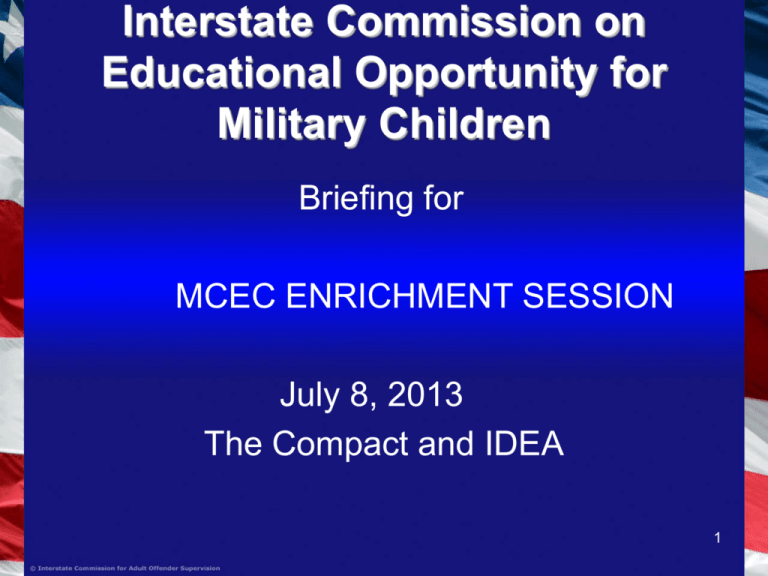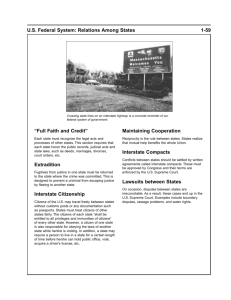ICAOS Legal Presentation - History, Legal Foundation
advertisement

Interstate Commission on Educational Opportunity for Military Children Briefing for MCEC ENRICHMENT SESSION July 8, 2013 The Compact and IDEA 1 History • Interstate Compacts are rooted in the colonial past. Because each colony was independent, disputes between them were worked out by negotiation that was submitted to the king for approval. • Thus interstate compacts are not new. What has changed in the last century is the use of interstate compacts to create on-going administrative agencies. 2 Legal Foundation 3 The Compact Mechanism • A simple, versatile and proven tool • Principal advantage: provides states with an effective, enforceable means of cooperatively addressing common problems – even though their own laws may differ – without relinquishing authority to the federal government 4 Interstate Compacts • Agreements between states authorized under Article I, Section 10, Clause 3 of the U.S. Constitution – the “Compact Clause” • “No State shall, without the Consent of Congress . . . enter into any Agreement or Compact with another State . . . “ • The U.S. Supreme Court has consistently held that Congressional consent is only required for compacts that tend to increase the political power of the states in a manner that encroaches upon or interferes with the just supremacy of the United States. [U.S. Steel Corp. v. Multi-state Tax Commission, 434 U.S. 452 (1978)] 5 Compacts • Approximately 200 compacts formed since the founding of the U.S. • Creation of the Port Authority of New York and New Jersey in 1921 signaled a new era in regulatory compacts. – About 38 are inactive – On average, each state is a member of 23 compacts 6 3 Primary Purposes • Resolve boundary disputes; • Institutionalize and manage interstate issues pertaining to allocation of natural resources; • Create on-going administrative agencies that have jurisdiction over a wide variety of concerns: • • • • • • • State transportation Taxation Environmental matters Regulation Education Corrections Public safety 7 Common Law Contract Principles • An offer to enter the agreement is expressed by statutory language enacted by the first state to join the compact and each subsequent jurisdiction accepts this offer by enacting statutory language, which is substantially similar to that enacted by the offering jurisdiction; • Once enacted by two or more states, a compact, like any other contractual agreement, is protected from impairment by the states under Article I, Section 10, Clause 1 of the U.S. Constitution (The Contract Clause); • Although a state cannot be bound by a compact to which it has not consented, once enacted a compact takes precedence over conflicting statutes of the state; • A state cannot unilaterally nullify, revoke, or amend one of its compacts if the compact does not so provide. 8 Compact Rulemaking • A state legislature’s ability to delegate regulatory authority to an administrative agency is “one of the axioms of modern government” -- Justice Felix Frankfurter • Extends to the creation of interstate commissions by compact -- West Virginia ex rel. Dyer v. Sims, 341 U.S. 22 (1951) 9 Interstate Compact for Educational Opportunity for Military Children • • • • So far, 46 States Adopted Remaining Non-Members: NY, OR, MN, NH Establishes a national governing body Rule making authority which has effect of law 10 National Structure • • • • • • • National Commission Executive Committee Finance Committee Rules Committee Training & PR Committee Other Committees as needed 11 State Structure • Provide mechanism for empowerment of Compact process; • Assist in developing Compact policy; • Determine qualifications for membership on Council; • Appoint Acting Commissioner when Commissioner is unable to attend. • State Education Supt. • Supt. of Dist. w/ high % of military children • Military Rep. • Exec. Branch Rep. • Leg. Branch Rep. • Other Stakeholders deemed appropriate 12 Compact Administration • Once Adopted, states internally: – Establish Councils for internal coordination – Appoint Military Family Education Liaison – Appoint Commissioner to represent the State – Assist in funding administrative functions of the Commission • Adopting States as part of Interstate Commission: – Jointly established an Interstate Commission composed of voting representatives from each member State to: • Draft and vote on rules • Provide oversight, education, guidance and enforcement • Resolve disputes • Establish funding formulas for member-state 13 assessments Substantive Compact Requirements • Applicability: – Active duty members (includes activated Guard and Reserves) – Severely injured members and veterans (for 1 year) – Members who die on active duty (for 1 year) 14 Substantive Compact Requirements • Compact includes specific rules to facilitate: I. Enrollment • Transfer of records –expedite proper enrollment and placement, 10 days to provide official record to receiving school • Immunization requirements- up to 30 days to get shots • Age of Enrollment – if enrolled age 4, 5, 6 in another state, then move here, allow them to continue 15 Substantive Compact Requirements II. Eligibility • Non-custodial parents - Allow child in care of non-custodial parents in another jurisdiction to continue in same school • Extracurricular activities - Facilitate ‘opportunity for inclusion’ • Tuition - prohibit LEA from charging tuition to child in care of non-custodial parent living in another jurisdiction • Power of Attorney Rights - Allow special POA for child of military family for purposes of enrollment and other actions of parent participation/consent 16 Substantive Compact Requirements III. Placement • Course placement – When transfer during school year, receiving school honor placement in courses of sending school, i.e., Honors, AP, IB, vocational, etc. • Placement flexibility – LEAs get waiver course or program prerequisite flexibility in their jurisdiction • Absence related to Deployment – Prior to, or returning from a combat zone, superintendent grant additional absences to visit with parent • Special Education – IDEA, provide comparable services on current IEP; 504 or Title II, equal access 17 Substantive Compact Requirements IV. Graduation • Waive similar coursework completed in sending state, or provide alternate means to graduate on time • Exit Exams - Accept: Exit or end of course exams from sending state, or National norm referenced achievement tests, or Alternative testing • Transfers during Senior Year – If not possible for Transferred Sr. to graduate in receiving state, diploma from sending state if student grad requirements are met 18 Art. V, Sec. C – Special Education Services • “In compliance with the federal requirements of the . . . IDEA . . . the receiving state shall initially provide comparable services to a student with disabilities based on his/her current . . . IEP; and in compliance with the requirements of Section 504 of the Rehabilitation Act . . . and Title II of the Americans with Disabilities Act . . . 19 Art. V., Sec. C. cont. “. . . the receiving state shall make reasonable accommodations and modifications to address the needs of incoming students with disabilities, subject to an existing 504 or Title II Plan, to provide the student with equal access to education. This does not preclude the school in the receiving state from performing subsequent evaluations to ensure appropriate placement of the student.” 20 Enforcement Power • Commission has authority to enforce the compact and its rules upon the states by: Require remedial training Require mediation/arbitration of dispute Impose monetary fines on a state Seek relief in federal court, most likely by obtaining an injunction to curtail state action or compel compliance 21 No Private Right of Action is Created by the Compact • Unless the statute ‘unambiguously confers’ a clear individual statutory right no violation of 42 U.S.C. Sec. 1983 exists [See Gonzaga University v. Doe, 503 U.S. 273 (2002); also, Doe v. Pennsylvania Bd. of Prob. & Parole, 513 F.3d 95 (2008)(applicable to interstate compacts)] 22 Immunity for Commissioners, Employees or Agents • Activities of the Commission are a ‘State Function’ • 11th Amt. immunity available to administrative agencies, including compact commissions if “good reason to believe” member states intended and so structured the new agency. [See Lake Country Estates v. Tahoe Regional Planning Agency, 440 U.S. 391, 401 (1979)] 23 Immunity for Commissioners, Employees, or agents cont. • Article XI, Sec. D.1. of the Compact provides that any liability of the employees or agents of the interstate commission within each state “may not exceed the limits of liability set forth under the Constitution and laws of that state for state officials, employees, and agents.” 24 Questions? Contact info: • • • Norman Arflack, Executive Director Interstate Commission on Educational Opportunity for Military Children Email: narflack@csg.org; Phone: (859) 244-8069 Rick Masters, General Counsel Interstate Commission on Educational Opportunity for Military Children Email: rmasters@csg.org Phone: (502) 262-5881 25 Questions 26







